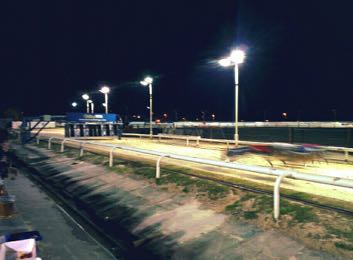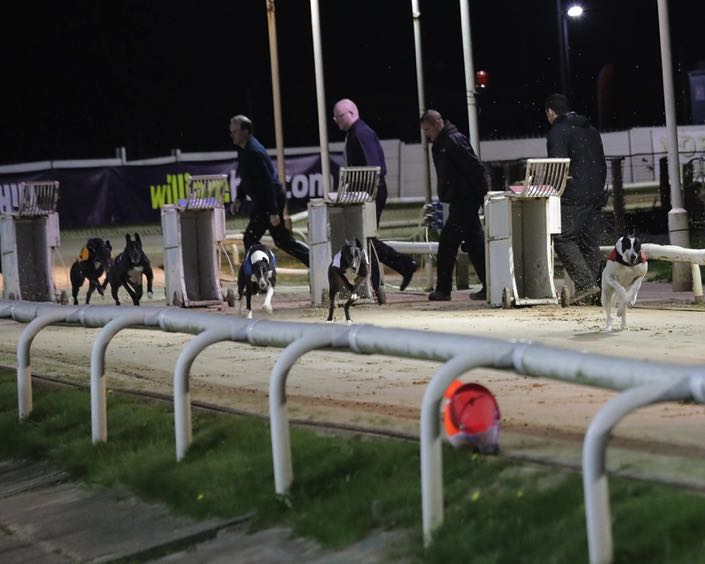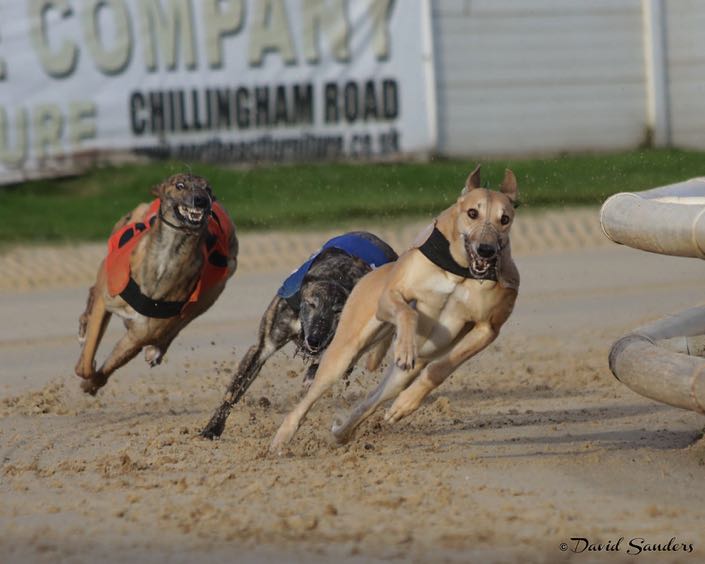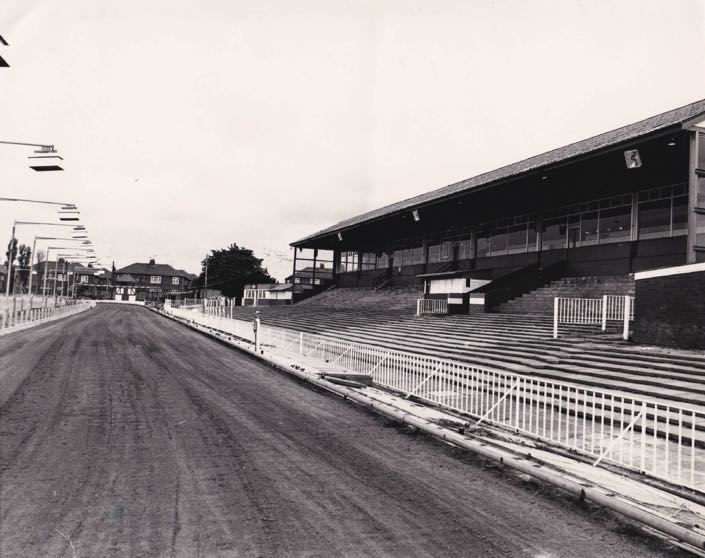- Address: Fossway, Newcastle upon Tyne NE6 2XJ
- Telephone: 01912 105300
- Website: newcastle-greyhounds.co.uk

When it comes to greyhound racing, one of the appeals of it as a sport is that it still has a sense of character. That is very much in evidence at Brough Park Dog Racing Track, which will be better known to most people as Newcastle Greyhound Stadium. Racing takes place there on Tuesdays, Wednesdays, Thursdays and Saturdays. If you’re interested in racing and not too bothered about what it is that is doing the racing then you might want to consider heading there between March and October for some speedway action on the track.
Brough Park opened its doors in 1928, becoming the city’s second greyhound stadium after a track that had been opened by Tyneside Sports Stadium Limited a month before. Nowadays, it is officially called Newcastle Stadium after it was bought by the Arena Racing Company, but it will always be Brough Park in the minds of lovers of the sport. The venue’s first-ever race was won by a dog called Marvin, who had odds of 3/1. Despite the general decline of greyhound racing across the United Kingdom, Newcastle Stadium remains a popular place to go.
The Track & Facilities

The circumference of the track at Brough Park is 415 metres, with the facilities on offer being generally decent. The venue was renovated in 2003, so it is starting to show signs of ageing now for the punters that pay it a visit for the racing. As with most greyhound venues, Newcastle Stadium is built to welcome large numbers of people, making it an ideal location for those hoping to attend with large groups. The overall capacity is 1,000, making it quite small in comparison to some other venues but still more than big enough.
At the time of writing, Newcastle Stadium boasts a few different race lengths. These are as follows:
- 290 Metres
- 480 Metres
- 500 Metres
- 640 Metres
- 670 Metres
- 706 Metres
- 825 Metres
- 895 Metres
In addition to those races, there are also hurdle races that take place over 480 metres and 500 metres. The run to the first bend stands at 103 metres in races of about 480 metres, whilst the course uses an Outside Swaffham hare to get the dogs running.
Major Races & Events

The majority of greyhound racing venues have at least some noteworthy races for you to consider, with Newcastle Stadium being no exception. Unlike some of the bigger and more popular locations, the number of races is maybe slightly down on what punters have come to expect. Even so, as one of the most northern greyhound racing locations, it is hardly a surprise that Brough Park’s events are some of the most loved by those that tend to rock up to the stadium on a regular basis. Here is a quick look at them:
Northern Flat
First run in 1927, the Northern Flat takes place over 480 metres and currently offers £10,000 to the winning greyhound’s connections. Held annually, the race used to take place at Belle Vue Stadium in Manchester but was moved to Newcastle after Belle Vue closed its doors for the final time in 2018. It took three years before it re-started here, but it has taken place at Brough Park since 2021. In 1971, the race featured eight dogs, making it the only time a major competition had eight runners.
All England Cup
Inaugurated at Brough Park in 1938, the All England Cup is a greyhound racing competition that is run over 480 metres. Taking place on the sand track at Newcastle, it currently offers winning dogs and their connections £8,000 in prize money. In 1946, four entries in to the competition were the Derby winners of all four of the home nations, with Mondays News having won the English Greyhound Derby, Lilac Lady being successful in the Irish Greyhound Derby, the Welsh Greyhound Derby winner Negro’s Lad and Lattin Pearl, who won the Scottish Greyhound Derby.
Northern Puppy Derby
One of the youngest big-name races in the greyhound racing calendar, the Northern Puppy Derby is, coincidentally, only open to young dogs. Taking place for the first time in 1994, it is for greyhound puppies under the age of two and over 15-months. The winner gets £10,000 after running the 480 metres of the race. It began life at Sunderland Stadium as a race over 450 metres, moving to Newcastle Stadium and shifting to its current length in 2010. Typically run in October, the 2022 running saw it shift to February.
In the News
It isn’t always the case that greyhound stadiums are in the news for good reasons, but Newcastle Stadium has bucked that trend in recent years. In March of 2021, for example, Lee Westwood took one of his greyhounds to the venue in the hope of seeing it win the Northern Puppy Derby. The famous golfer owned Dannid with Andrea Wylie, but had to settle for watching the favourite, Jaguar Macie, fulfil her promise and win the race. It meant that she won a GBGB Category One double, having already won the Ladbrokes Puppy Derby the month before.
Almost a year later, Newcastle Stadium joined in with the celebrations taking place elsewhere in the city in honour of St. Patrick’s Day. With free cocktails being given away at one location and a football match being broadcast on big screen, Brough Park attempted to pull in the punters by offering a race card with 12 different events on it. Not only that, but anyone looking to head to the venue were able to get in for free in order to watch the races. It was a feel good occasion after a few years of muted celebrations.
About Newcastle Greyhound Stadium

In 1928, a site was chosen near to Walker where a greyhound stadium could be built. It was previously the location of the north end of a football ground and some allotments, so the hope was that it would be relatively easy to convert it to make it ready for some racing. It was built to the south of Fossway, with the resident kennels constructed on the route of Hadrian’s Wall. They were large, allowing for the housing of greyhounds for both Brough Park and, in later years, Gosforth Greyhound Stadium. The third and forth bends of the track were found to the south of the kennels.
The first major change for Brough Park, as the track was known then, came in 1938 when the All England Cup was first run there. This saw an influx of prize money that attracted many of the best greyhounds from further south. Racing was interrupted thanks to the outbreak of the Second World War, but when the war was over, things returned to normal. In the 1950s, the Racing Manager was Mr. Greeves, overseeing a period when such esteemed dogs as Endless Gossip and Just Fame were winning the Cup.
Changes to the Track
The 1960s was seen as an opportunity to upgrade the track, largely thanks to the arrival of new owners that installed a new manager. Totalisators and Greyhound Holdings took over ownership of Brough Park in 1964, with Dan McCormick being introduced as the new General Manager and Mr. R Slater taking over the Racing Manager position. Amongst the changes that were made was the decision to switch to an outside Navan hare, with the distances being 525, 650, 700, 750 and 880 yards. That included a 525 hurdle event.
Greyhound trainer, Norman Oliver, who was based out of Brough Park, won the Scottish Greyhound Derby in 1967 thanks to Hi Ho Silver, with Shady Begonia winning the English Greyhound Derby the year after out of the kennels. There were also successes for Newcastle-based trainers in the Gold Collar, the St. Leger and the Stewards Cup during the same time period. Oliver’s success continued in to the following decade, thanks to him being voted the Greyhound Trainer of the Year of 1973, though Ramdeen Stuart was beaten to the title of Greyhound of the Year by Patricias Hope.
New owners arrived at the stadium in 1974, largely thanks to the fact that TGH was bought by Ladbrokes. That means that Brough Park shifted to become a Ladbrokes venue, along with Gosforth, Crayford & Bexleyheath and Leeds. More improvements were carried out, including the opening of a new restaurant, whilst in 1977 the Trainers Championship was introduced to Brough Park. One of the biggest changes for a decade occurred in 1980, though, when the decision was made to move from a grass to sand track.
Uncertainty Arrives
In 1983, Glassedin Greyhounds Limited bought the track from Ladbrokes, with uncertainty immediately gripping all those involved. Even though the company was headed by the father of trainer Jane Glass, James Glass, the decision to sell the kennels for redevelopment meant that no one was quite sure what lay in store for Brough Park. Within a year, the track changed hands, moving from Glassedin Greyhounds Limited to Bernard and Joan Neesham. It was a period of huge uncertainty, with the Neeshams then selling it to Kevin Wilde in 1986.
Thankfully, a period of stability followed under the ownership of Wilde. Indeed, not much of note happened until 2003, which was when William Hill took over stewardship of it and made major investments in order to modernise it. They wanted to bring it more in-line with Sunderland Greyhound Stadium, bought by William Hill years before and undergoing improvements as a result. In 2007, a decision was taken to rename the track as Newcastle Greyhound Stadium, largely because Brough Park was then the only such venue in the city.
The Modern Era
The investment in the track made by William Hill earned its rewards. Within a couple of years, it was selected ads the venue to hold the Television Trophy, whilst the standard of dogs coming out of Newcastle was amongst the best in the country. In 2010, for example, Jimmy Wright won both the William Hill Classic and the William Hill Grand Prix on the same evening, thanks to Target Classic and England Expects. The changes weren’t completely over, however. In 2017, William Hill chose to sell the track to Arena Racing Company.
The move proved to be a good one, with Newcastle Greyhound Stadium quickly gaining one of the most prestigious competitions in the sport: the Laurels. That was thanks to ARC taking it over from the Greyhound Racing Association, but it was only run there three times before the world situation shut down greyhound racing for a time. When it restarted in 2021, the Laurels had moved to Perry Barr Stadium. Even so, its brief spell at Newcastle was proof that the stadium was still well respected within the industry.
The records for the races run at Newcastle Stadium are as follows:
| Distance | Record Time (Seconds) | Date Set |
|---|---|---|
| 290 Metres | 16.63 | 1st June, 2019 |
| 480 Metres | 27.90 | 1st July, 2004 |
| 500 Metres | 29.52 | 27th May, 2004 |
| 640 Metres | 38.56 | 21st April, 2021 |
| 670 Metres | 40.43 | 16th September, 2017 |
| 706 Metres | 42.79 | 22nd April, 2017 |
| 825 Metres | 50.44 | 13th July, 2004 |
| 895 Metres | 55.81 | 8th October, 2013 |
| 480 Metres Over Hurdles | 30.10 | 18th September, 2001 |
| 500 Metres Over Hurdles | 31.06 | 22nd February, 1992 |